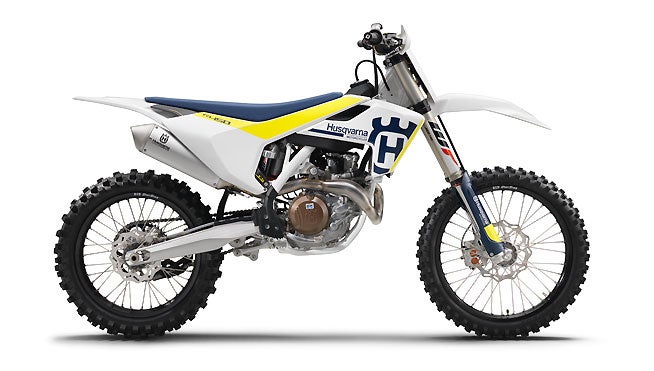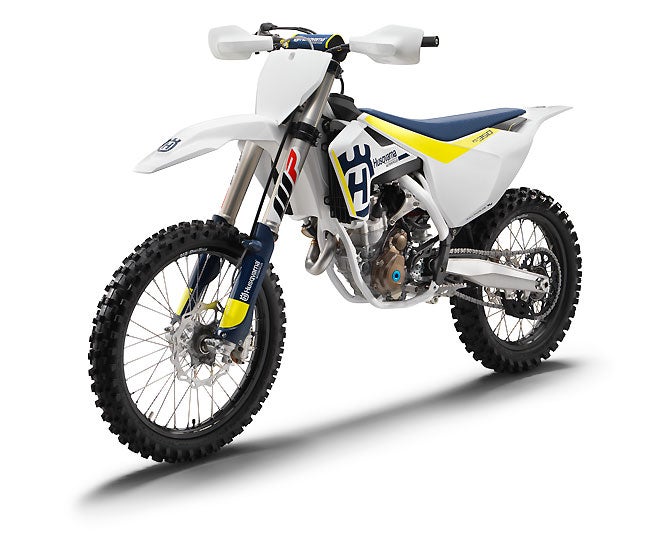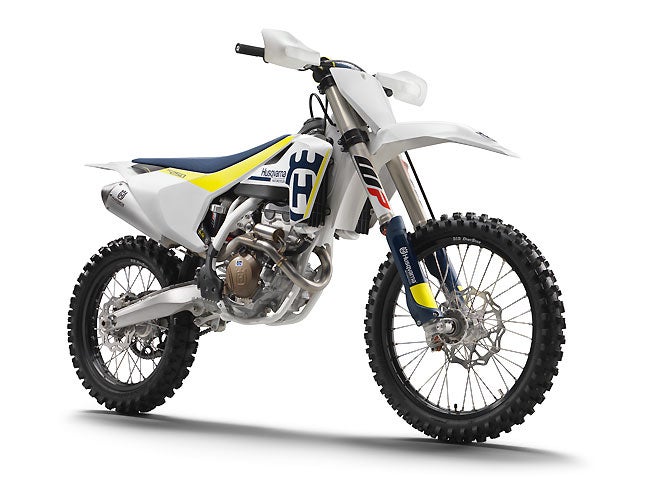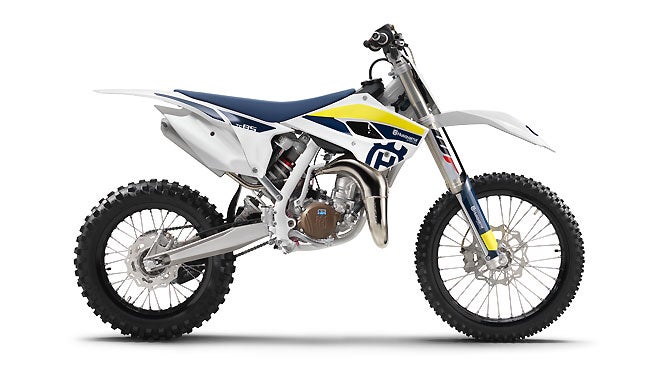2017 Husqvarna FC 450

Husqvarna’s flagship FC 450 returns with upgrades that include the new traction control system the new WP AER 48 air fork.
The FC450’s liquid-cooled, fuel-injected four-stroke Single boasts a claimed 63 horespower with an overall weight of just 61.3 pounds. Its compact cylinder head features and SOHC design that actuates four lightweight titanium valves weighing 32 grams on the intake side and 28 grams on the exhaust side. The valves measure 40mm in diameter on the intake side and 33mm on the exhaust side. Low-friction DLC coating on the rocker arm and low-friction chain guides are used to reduce friction inside the engine. The FC450’s 95mm CP bridge-box-type piston weighs only 320 grams. Compression ratio is 12.6:1 .
Husqvarna says that the FC450’s crankshaft is specifically positioned to harness the rotating mass in the ideal center of gravity for a lightweight and agile handling feel. The crank rides in plain bearings, and Husqvarna claims a service interval of 100 hours.
The FC450’s high-pressure die cast cases are designed to be compact and to house the shaft arrangements and internals of the engine in a position that Husqvarna believes will deliver the best possible handling. Additionally, the clutch shaft is positioned to keep the clutch above the oil level to decrease drag inside the engine.
The FC450’s five-speed gearbox features a low-friction coating on the shift fork to endure smooth and precise shifting. The gear lever is designed to prevent dirt build-up in muddy riding conditions. An advanced gear sensor allows for specific engine maps in each gear.
The FC 450 features a DDS (Damped Diaphragm Steel) clutch as opposed to the CSS clutch found on the FC250 and FC350. The DDS uses a single diaphragm steel pressure plate instead of traditional coil springs. The clutch basket is a single-piece CNC machined steel component that allows the use of thin steel liners to help keep the overall engine dimensions more compact.
The FC450 utilizes and electric starting system (there is no kick starter on the machine) powered by a compact Li-Ion battery.
2017 Husqvarna FC 350

The Husqvarna FC 350 strikes the middle ground between the agility of a 250cc four-stroke and the ground-smacking power of a 450cc machine. The FC 350 shares much of its engine and chassis architecture with the smaller FC 250, but a larger bore and stroke allow its liquid-cooled, fuel-injected DOHC engine to achieve a claimed 58 horsepower at the output shaft, rivalling the power-to-weight ratio of the FC 450. The FC 350 also receives the advanced EMS of the FC 450, featuring launch control, switchable engine maps and traction control as well as the WP AER 48 air fork.
2017 Husqvarna FC 250

Husqvarna claims that its FC 250 is one of the most technologically advanced 250cc motocrossers ever, and for 2017 the quarter-liter thumper returns with the all-new WP AER 48 fork as well as a new, wider Dunlop 110/90-19 rear tire as opposed to the 100/90-19 found on the 2016 model. The FC 250’s compact, liquid-cooled, fuel-injected DOHC engine produces a claimed overall power output of 46 horsepower at the output shaft while revving to 14,000 rpm. That power is transmitted through a CSS (Coil Spring Steel) clutch with Magura hydraulics. The CSS clutch has six coil springs, seven clutch plates, and a one-piece CNC machined steel clutch basket.
2017 Husqvarna TC 85

The last of the previous-generation Husqvarna motocrossers, the TC 85 receives the new graphics of its larger siblings while retaining the same high-performance features as last year’s TC 85. These include a high-winding two-stroke engine on that features a power valve to maximize the powerband. The TC 85 also features a six-speed transmission and a formula hydraulic clutch for smooth and precise shifting. Using a chromoly steel frame with an aluminum subframe. Suspension is, of course, from WP, with a 43mm coil spring steel fork up front a fully adjustable WP rear shock attached via a linkless PDS (Progressive Damping System) mount.
 Your Privacy Choices
Your Privacy Choices